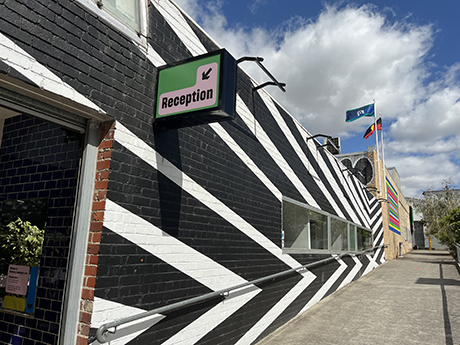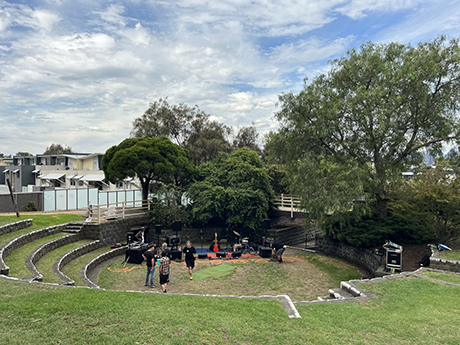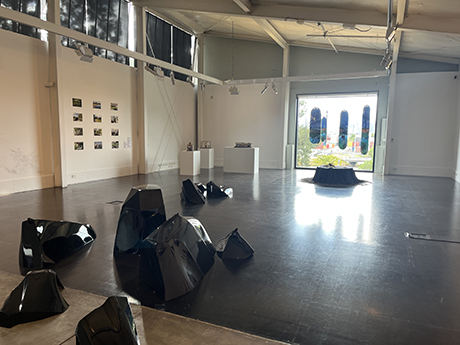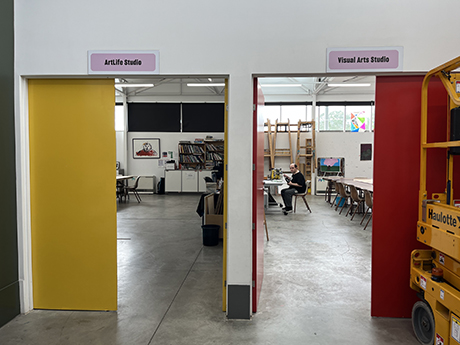Footscray Community Arts
https://footscrayarts.com/

Exterior view of Footscray Community Arts

Amphitheatre

Roslyn Smorgon Gallery

Studio
Pursuing dialogue between the Indigenous and Immigrant communities
Footscray Community Arts

(C) Footscray Community Arts
Senior Producer of Footscray Community Arts
Located in the suburbs of Melbourne, Footscray Community Arts (established 1974) seeks to use art as a medium for promoting dialogue between the Indigenous community and Immigrant communities, through means such as appointing Indigenous Advisory Group members.
Footscray Community Arts
https://footscrayarts.com/

Exterior view of Footscray Community Arts

Amphitheatre

Roslyn Smorgon Gallery

Studio
*1 In Australia, as part of efforts to promote harmony with Indigenous communities, it is recommended to start by expressing respect to the indigenous peoples and their ancestors in the land where the work is carried out, such as when speaking in public.
*2 The White Australia policy is a policy that seeks to limit non-white settlement in Australia. One of them was the Immigration Restriction Act on December 23, 1901. This was one of the first legislation introduced in the newly formed Bundestag and was intended to restrict the migration of non-British nationals to Australia. With the enactment of this law, the White Australia policy was formally established. This policy was abolished in 1966.
*3 Gough Whitlam (1916–2014) was an Australian politician, 21st Prime Minister (1972–75), and Labor Party. Fair go was based on Whitlam’s campaign slogan, “Give Gough a fair go,” and became a term that expressed the egalitarian spirit.
*4 The Reconciliation Action Plan is an action plan for reconciliation and cooperation with Indigenous communities established by local governments in Australia. Action guidelines that can be practiced on various scales such as companies, organizations, and individuals are presented. One of them is Dan’s words of gratitude to his ancestors and land at the beginning.
*5 A Songline is one of the paths that show the trajectory of Aboriginal ancestors. It is told as a path that spans the earth or sky through songs, stories, dances and paintings.
*6 Wominjeka Festival was held on October 22, 2022 for the first time in three years. The welcome ceremony included an important ceremony in which cloaks made from new possums were presented to “Elders in Residence” Uncle Larry Walsh and N’Arweet Dr. Carolyn Briggs AM. Some 300 attendees enjoyed Aboriginal arts and crafts markets, live performances, DJs and food throughout the day. The event was also welcomed by the Aboriginal community and demonstrated Footscray Community Arts’ enthusiasm for its “First Nations First” policy.
*7 The Emerging Creative Leaders program is a leadership development program for artists in the fields of art, theater, video, literature, broadcasting, etc., and those who work there.
*8 An award for visual art established in 2016 and held every other year. There are the main Footscray Art Prize for Australian artists aged 18 and over (Main Prize, Local Awards for Western Artists, Resident Artist Prize for Resident Artists for Resident Creation and Exhibition at Footscray Community Arts) and Young Artist Prize for Primary and Middle School students in West Melbourne. An exhibition will be held to display all the award-winning works and entries in the Young Artist Category.
*9 Dreamtime is a word that describes the creation of the world. It has a unique Aboriginal sense of time, history and memory.
*10 Aboriginal people had no literacy to read or write and conveyed a variety of information through dotted patterns and other drawings. Aboriginal art is said to have originated in 1971 when artists began painting with acrylic paint on canvas under the guidance of Geoffrey Bardon, a British art teacher. The characteristic painting methods of this genre are dot painting (pointillism) and X-ray painting, in which animal skeletons are drawn as if the animals are transparent.
*11 Situationists are cultural and political movements that emerged in France and other European countries from the 1950s. They rebelled against the existing systems of society, politics, culture, art, and life as represented by mass consumption, and aimed to “construct a situation” that created a moment of liberated life that was not controlled by it. It also influenced youth activities during the May Revolution in Paris (1968) and British punk in the 1970s.
*12 Dan’s Aboriginal great-grandfather had two families, one with an Aboriginal wife (Black) and one with an English wife (Brown). The trauma experienced by the Black family was due to discriminatory laws that created a “Stolen Generation” for colonial Aboriginal people (policies separating Aboriginal children from their parents, cultural and language controls, confiscation of land rights, forced migration, etc.), and the trauma experienced by the Brown family concealed and denied Aboriginal identity. It was due to their choice to assimilate into mainstream culture and avoid discrimination.
Related Tags